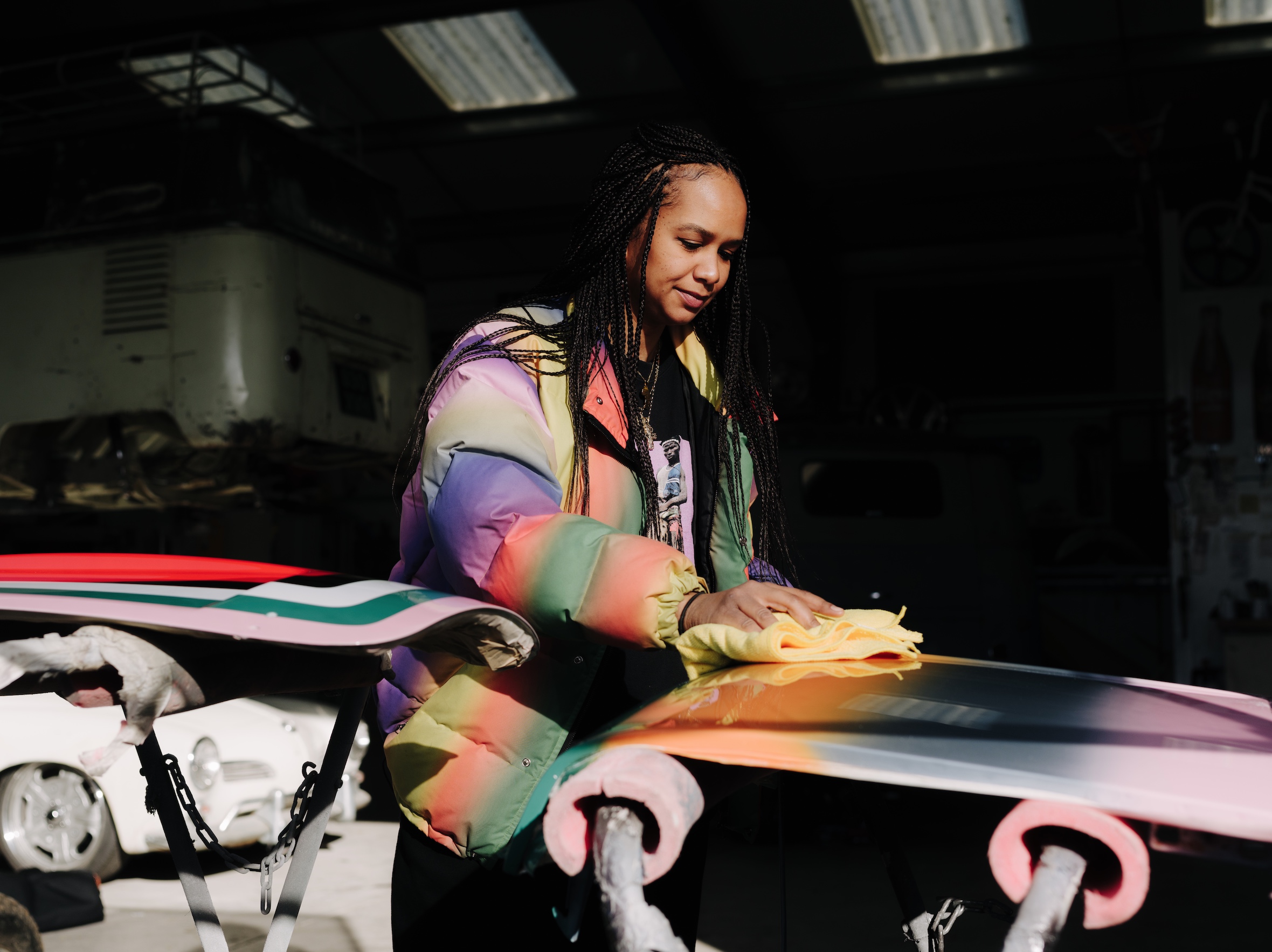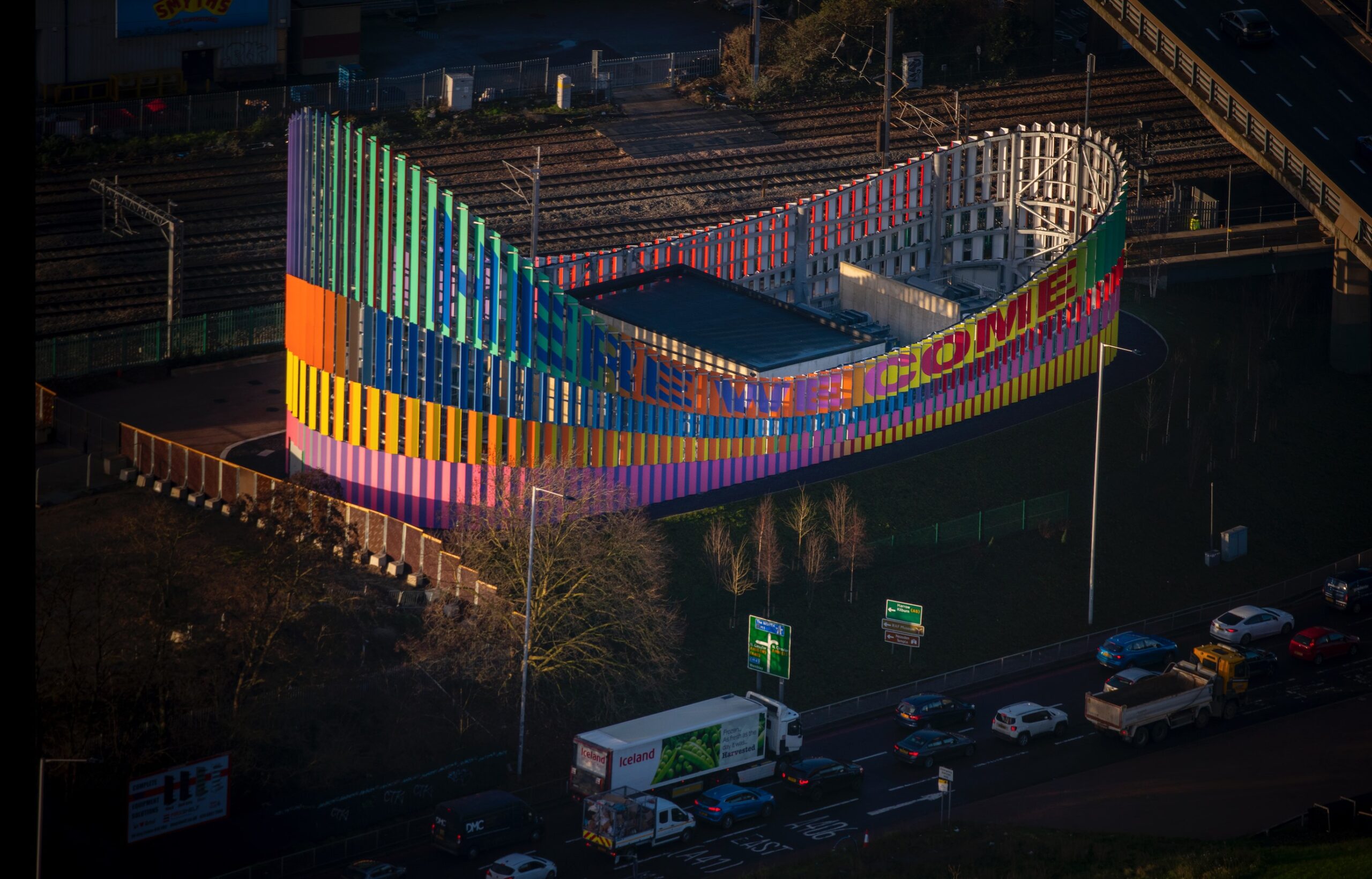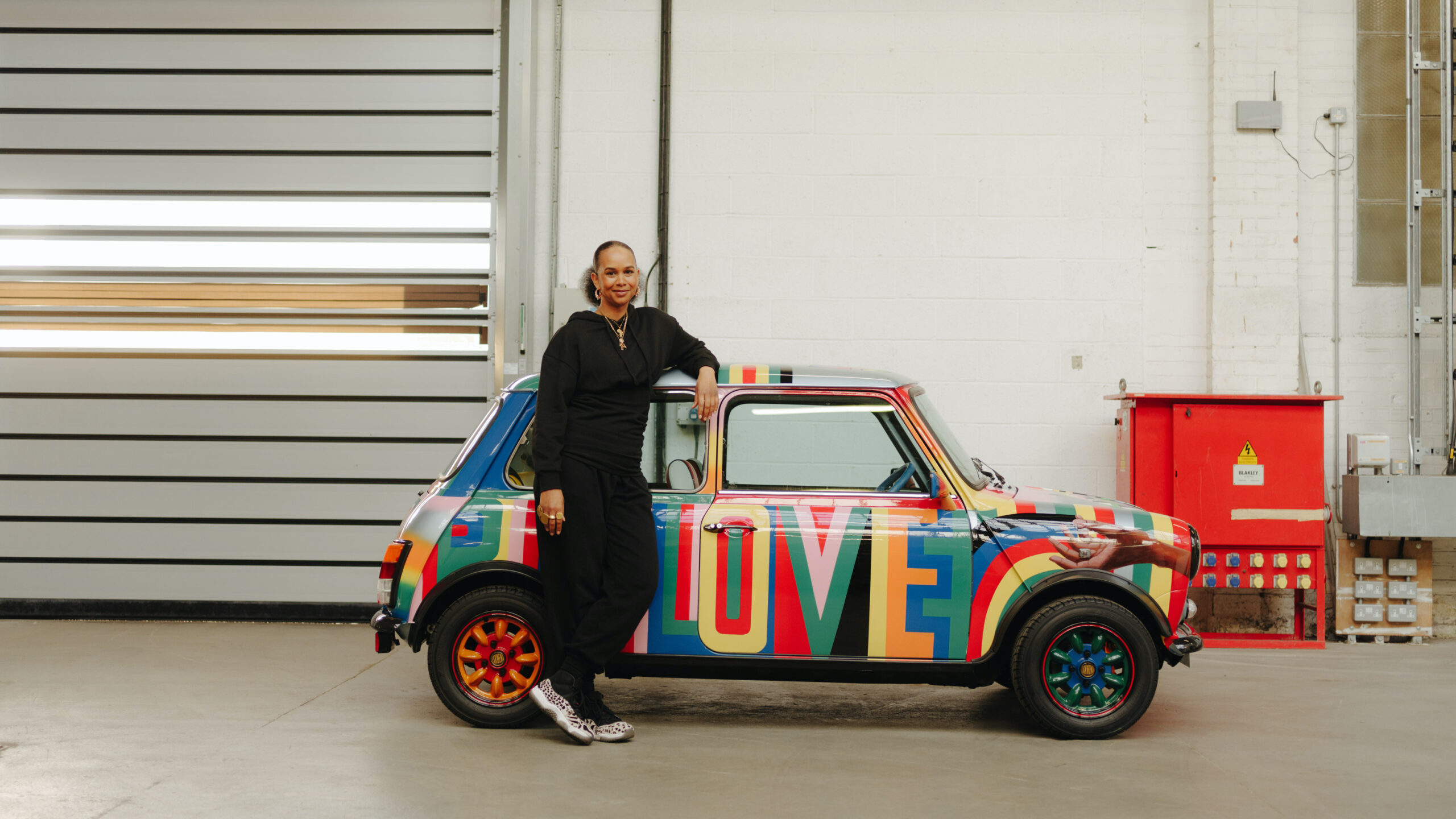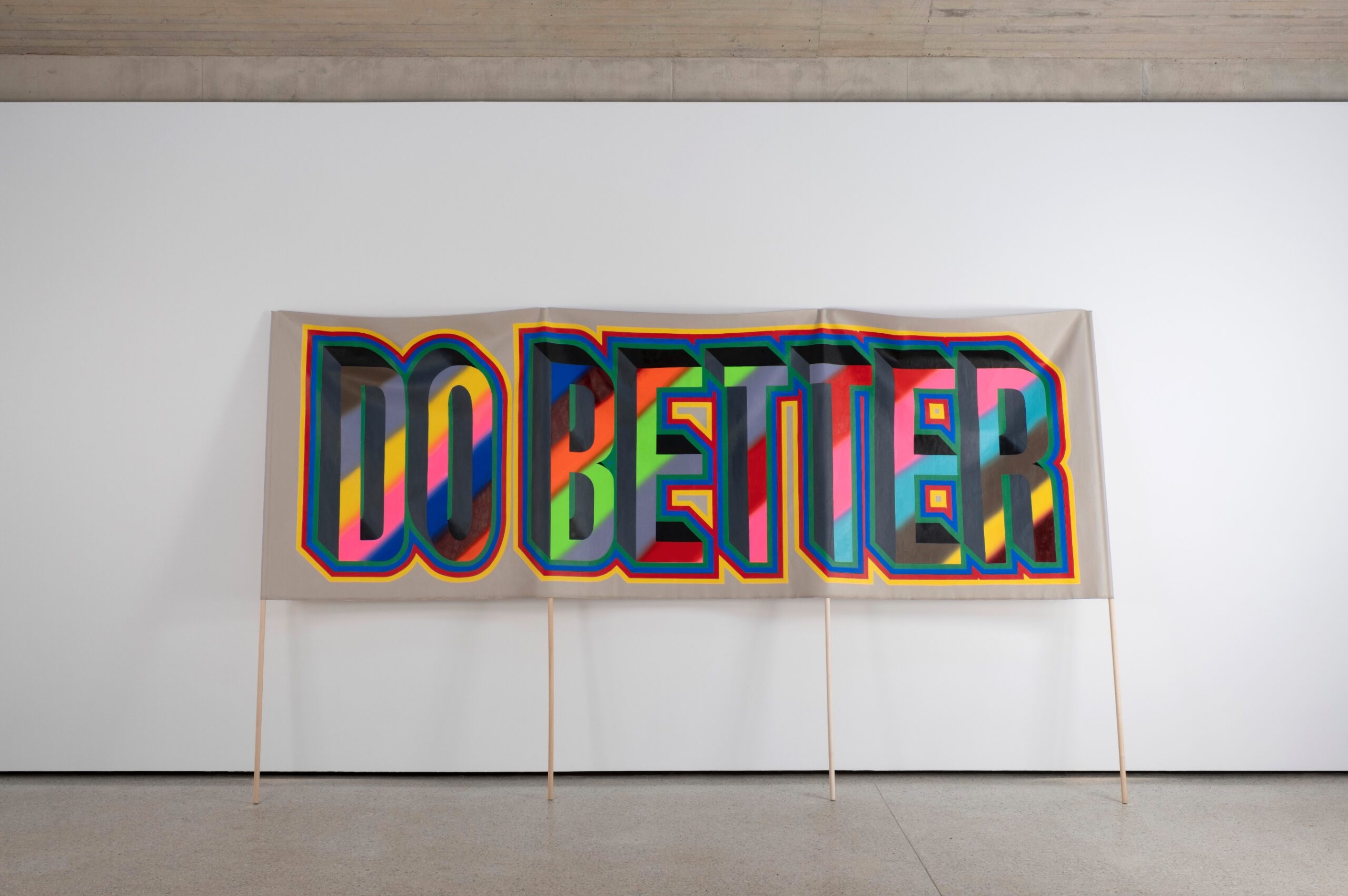From clothes for Fiorucci to spectacular architectural structures with IF_DO, Lakwena Maciver’s artworks are all around us
 Photography courtesy of MINI and Lakwena
Photography courtesy of MINI and Lakwena
Words by Riya Patel
‘It’s like an alien mothership has landed,’ says Lakwena Maciver. ‘But in a really good way.’
The British artist describes her largest three- dimensional work to date: a spectacular structure to cloak the electrical substation of a housing development in Brent Cross, outer London. Here We Come, Here We Rise – a collaboration with architecture practice IF_DO – also reads like a funfair rollercoaster: the lightweight framework of brightly coloured slats swoops higher at one end and is emblazoned with bold lettering that spells out the artwork’s name.
Designed to be seen ‘at multiple speeds, levels and directions’ the permanent public artwork is an attention-grabbing totem for the emergent neighbourhood, much like the playground of forms that make up Stratford’s Olympic Park. The design is inspired by rotating advertising billboards, now commonly replaced by digital screens. Each fin of the structure is a lenticular, so the whole reveals itself differently depending on the angle from which it is viewed.
Maciver (who often goes by just her first name) has built a reputation for using vibrant colours and bold patterns to communicate uplifting messages. At the large scale these include blocky mosaics that transform ordinary pavements and giant murals that march across building surfaces. Mostly interventions in dense urban landscapes, these artworks are a moment of relief from grey city backdrops and the dreariness of the everyday.
 Photography by Jason Hawkes featuring ‘Here we come, here we rise’, Brent Cross Town substation artwork
Photography by Jason Hawkes featuring ‘Here we come, here we rise’, Brent Cross Town substation artwork
‘I often talk about my work in terms of an interruption to the difficulties and the pain of life,’ she says. ‘I hope it lifts people up and inspires them.’ She also works at the more personal scale. In polite gallery spaces her panels of painted plywood and sequin-embroidered cotton shout like protest banners or street graphics.
Collaborations with the likes of MINI, Italian brand Fiorucci in 2021, and most recently high- street chain Uniqlo, show the same sensibility transferred to fashion, a natural fit with the artist’s flair for mixing colour, typography and pop cultural motifs.
In an era when digital art-making is on the rise, and artificial intelligence capable of creating eerie dreamscapes that play with our sense of reality, Maciver’s art is gloriously lo-fi. The impactful aesthetic of the early internet comes to mind, with its basic fonts, rough gradients, drop shadows and rainbow-coloured fills. She reminds us that tactility and physical presence are still important ways for art to be experienced.
The prominence of words in her work comes from having studied graphic design at London’s College of Communications. ‘It always starts with the words,’ she says. ‘They are the soul of the thing. The colour and pattern is just a vehicle for them.’ Phrases might come from song lyrics, personal thoughts or snatches of everyday conversation, and are carefully chosen for their ability to connect with a wide audience.
 Photography by Dan Wilton and courtesy of MINI and Lakwena
Photography by Dan Wilton and courtesy of MINI and Lakwena
Accessibility is a key theme in her work. Maciver was inspired by the college’s printing presses, revolutionary in their time for spreading ideas quickly to a wide audience. ‘Graphic design is more intentional than fine art in terms of image-making,’ she says. ‘You have to think about: What does this image say? How does it impact people? The power of images and the ability to disseminate ideas is what appeals to me.’
Connecting with people in times of difficulty is crucial to the emotional impact of the work. This is finding resonance with audiences in an uncertain economic climate and cost of living crisis. ‘My work is definitely political, even though it might not be super explicit,’ she says. ‘There is a line to tread between saying what I want to say and sticking within the parameters that enable me to make the work.’
For public artworks like the substation structure, her choice of words is subject to an approval process often requiring several revisions. In the late 2022 exhibition A green and pleasant land (HA-HA) at Yorkshire Sculpture Park, she had the freedom to use language more directly. The show reflects on the park’s setting in the 200ha of the Bretton Hall estate, and an 18th-century land act that saw much of English countryside transferred from public to private ownership.
Works in the show such as Do Better and Re‐Educate the World hint at the parallels with today, a time when private interests still control public space and freedom of speech. In The Weston Gallery, a calm building of timber, glass and pigmented concrete added to the park by Feilden Fowles in 2019, Maciver’s jarring compositions in blocks of fluorescent colour and giant lettering are a stark contrast.
 Photography by Jonty Wilde and courtesy of Lakwena
Photography by Jonty Wilde and courtesy of Lakwena
Cover Your Mouth is a crumpled banner of ripstop fabric that hangs dramatically in the space from thick rope which also pools at the viewer’s feet. ‘This is the show that I’ve provoked the audience the most with,’ she says. ‘But I’m also aware I don’t want to alienate them. I don’t want to make something that completely switches people off.’
The looping, towering substation artwork is now part of London’s fabric, and a sight that hundreds will encounter each day. While this first collaboration in the architectural realm will inevitably lead to further public commissions, she appreciates being able to go between the gallery and the city as a canvas.
‘Institutions carry a weight and being able to make work in that space is incredible,’ she says. ‘I also want to keep making work in public spaces because it’s more democratic. I want to keep doing all of it, to be honest! But you never really know what’s going to happen with art.’
Get a curated collection of design and architecture news in your inbox by signing up to our ICON Weekly newsletter


















